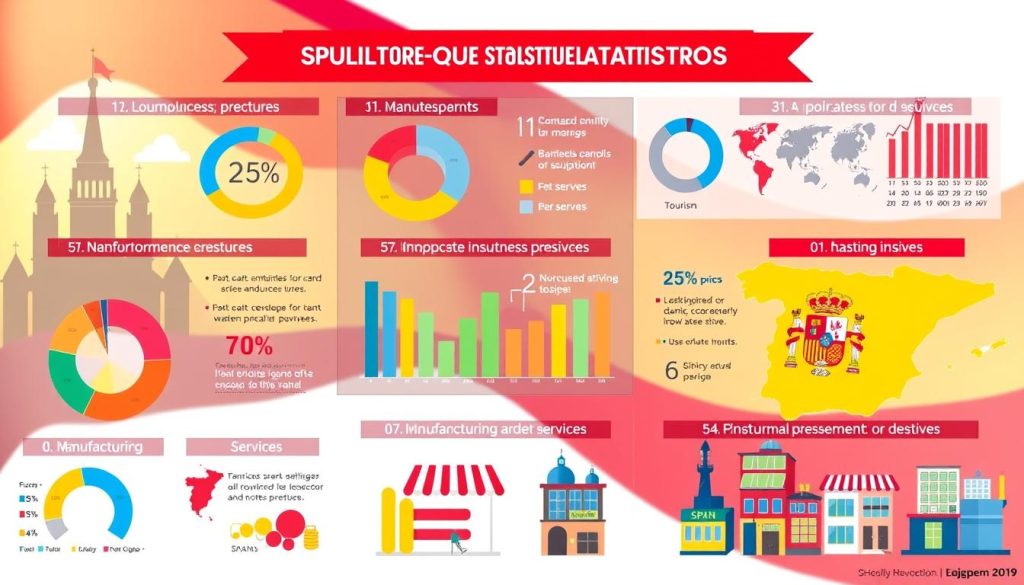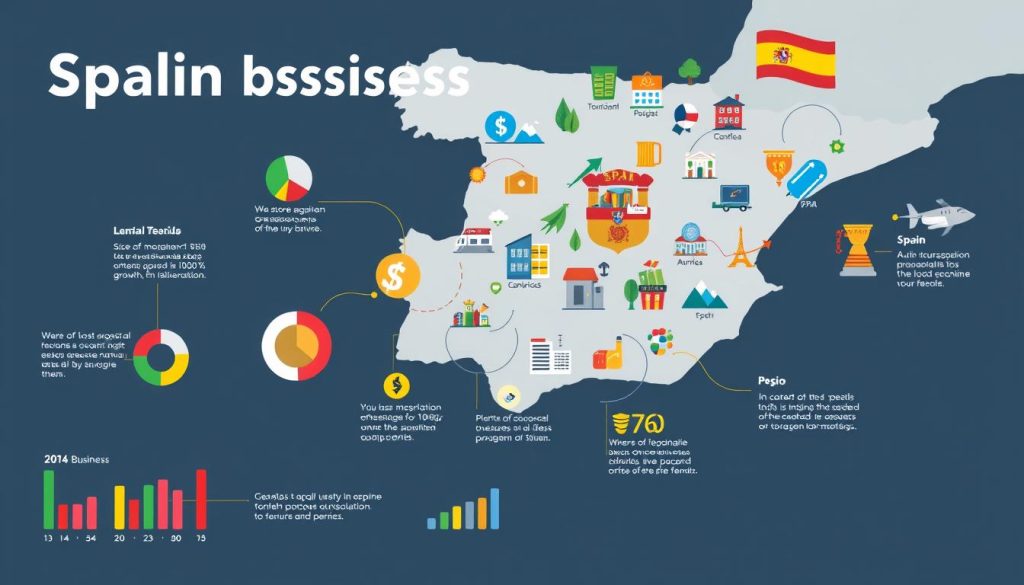We are excited to share a detailed look at structural business statistics in Spain. We focus on the trade and industrial sectors. This data is key for businesses and stakeholders to understand market trends, turnover, productivity, and how different regions perform.
Knowing these statistics is vital for making smart decisions about growing and investing. With Spain’s GDP per capita at 85% of the EU average by 2022, using accurate data is more important than ever. It helps us tackle today’s economic challenges.
We will examine the current state of Spain’s trade and industrial sectors. We’ll see how these statistics are crucial for strengthening Spain’s economy.
Overview of Structural Business Statistics in Spain
Understanding Spain’s structural business statistics is key to grasping the economy. It shows the importance of these stats in making policies and guiding investments.
Importance of Structural Business Statistics
These statistics are crucial for understanding Spain’s economy. They give insights into how businesses perform and what they are like. This helps in making better policies and planning for the future.
Scope of the Data Collected
The data collected covers many economic areas, like turnover and productivity. It also follows European rules, like Regulation 2019/2152, to improve data quality. This helps track the economy and see changes in the market.

Key Indicators of the Trade Sector
The trade sector is crucial for Spain’s economy. It shows important trends in turnover and productivity. In 2022, we saw big changes that show how vital this sector is for economic growth in different areas.
Turnover and Productivity Trends
In 2022, the Spanish trade sector’s turnover jumped by 13.6%. It reached a total of 955,065 million euros. This rise in turnover was matched by a 3.9% increase in productivity, reaching 43,026 euros per employee.
These numbers show strong growth in the trade sector. They help us understand the economy better, especially how it relates to GDP. Foreign trade made up 81% of Spain’s GDP during this time.
Regional Contributions to Trade Sector Performance
The trade sector’s performance varied across different Autonomous Communities. Madrid was the biggest contributor, making up 25.8% of trade turnover. Cataluña was close behind with 19.1%.
These figures show how economic activity is concentrated in certain areas. This affects the country’s overall performance and offers many investment opportunities. Knowing how these regions work helps us see the full picture of Spain’s trade sector.

Structural Business Statistics in Spain
Looking into Spain’s economy means we must understand its business statistics. These stats show how the economy grows and stays strong despite global challenges.
Annual Growth Rates and Economic Resilience
In 2022, Spain’s economy showed great strength, growing by 5.5%. This shows how different areas, like trade, have thrived even when things got tough. The Structural Metal Product Manufacturing industry grew by 9.2% from 2019 to 2024. By 2024, this industry’s market size hit €14.0 billion, showing it’s still growing strong.
Impact of Global Challenges on the Trade Sector
The trade sector faced big challenges like supply chain problems and high inflation. But, thanks to EU funding and recovery plans, it’s bounced back. In 2022, trade turnover jumped by 13.6%, reaching 955,065 million euros. This shows the sector’s ability to overcome tough times.
Insights into the Industrial Sector
The industrial sector is key to Spain’s economy, showing big turnover growth and unique company traits. In 2022, turnover jumped by 26.5%, reaching 928,151 million euros. This big increase shows the strong manufacturing activities driving the sector.
Industrial Turnover and Growth in 2022
This growth shows not just resilience but also growing confidence in making things. Industries have adjusted to new market needs. This signals a bright future for the sector’s economic growth.
Characteristics of Companies in the Industrial Sector
Nearly 90% of companies in the sector are makers, making up 76.3% of all turnover. This shows how much the sector depends on making things. Knowing these traits helps us understand the sector better and make plans for growth.
Trade Relationships and Economic Impact
Spain’s trade with the world has a big effect on our economy. A key example is our strong bond with the United States. Spain is the fourth-largest economy in the Eurozone.
In 2022, U.S. exports to Spain jumped to $35.3 billion. This was a 56.3% rise from the year before. The U.S. enjoyed a trade surplus of $4 billion, showing our economies are closely linked.
Spanish investments in the U.S. have also grown. This shows Spain’s important role as an investor. It also helps create a strong trading environment.
These trade ties let Spanish businesses reach more markets. This diversifies opportunities and makes our economy stronger. Looking ahead, these partnerships will be key in dealing with global economic changes.
In summary, imports and exports shape Spain’s economy. Trade relationships boost our GDP, which is $1.73 trillion in 2024. As we grow these connections, understanding their impact is vital for our economic future.

